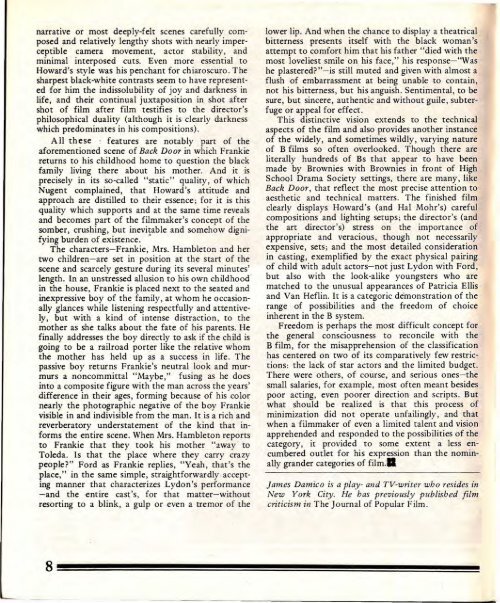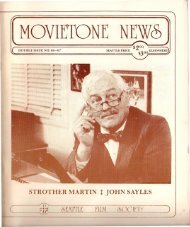MOVIETONE NEW8 . - Parallax View Annex
MOVIETONE NEW8 . - Parallax View Annex
MOVIETONE NEW8 . - Parallax View Annex
You also want an ePaper? Increase the reach of your titles
YUMPU automatically turns print PDFs into web optimized ePapers that Google loves.
narrative or most deeply-felt scenes carefully composed<br />
and relatively lengthy shots with nearly imperceptible<br />
camera movement, actor stability, and<br />
minimal interposed cuts. Even more essential to<br />
Howard's style was his penchant for chiaroscuro. The<br />
sharpest black-white contrasts seem to have represented<br />
for him the indissolubility of joy and darkness in<br />
life, and their continual juxtaposition in shot after<br />
shot of film after film testifies to the director's<br />
philosophical duality (although it is clearly darkness<br />
which predominates in his compositions).<br />
All these : features are notably part of the<br />
aforementioned scene of Back Door in which Frankie<br />
returns to his childhood home to question the black<br />
family living there about his mother. And it is<br />
precisely in its so-called "static" quality, of which<br />
Nugent complained, that Howard's attitude and<br />
approach are distilled to their essence; for it is this<br />
quality which supports and at the same time reveals<br />
and becomes part of the filmmaker's concept of the<br />
somber, crushing, but inevitable and somehow dignifying<br />
burden of existence. -<br />
The characters-Frankie, Mrs. Hambleton and her<br />
two children-are set in position at the start of the<br />
scene and scarcely gesture during its several minutes'<br />
length. In an unstressed allusion to his own childhood'<br />
in the house, Frankie is placed next to the seated and<br />
Inexpressive boy of the family, at whom he occasionally<br />
glances while listening respectfully and attentively,<br />
but with a kind of intense distraction, to the<br />
mother as she talks about the fate of his parents. He<br />
finally addresses the boy directly to ask if the child is<br />
going to be a railroad porter like the relative whom<br />
the mother has held up as a success in life. The<br />
passive boy returns Frankie's neutral look and murmurs<br />
a noncommittal "Maybe," fusing as he does<br />
into a composite figure with the man across the years'<br />
difference in their ages, forming because of his color<br />
nearly the photographic negative of the boy Frankie<br />
visible in and indivisible from the man. It is a rich and<br />
reverberatory understatement of the kind that in-<br />
forms the entire scene. When Mrs. Hambleton reports<br />
i to Frankie that they took his mother "away to<br />
Toleda. Is that the place where they carry crazy<br />
people?" Ford as Frankie replies, "Yeah, that's the<br />
place," in the same simple, straightforwardly accepting<br />
manner that characterizes Lydon's performance<br />
-and the entire cast's, for that matter-without<br />
resorting to a blink, a gulp or even a tremor of the<br />
lower lip. And when the chance to display a theatrical<br />
bitterness presents itself with the black woman's<br />
attempt to comfort him that his father "died with the<br />
most loveliest .smile.on his face," his response-v'Was<br />
he plastered?"-is still muted and given with almost a<br />
flush of embarr.assment at being unable to contain,<br />
not his bitterness, but his anguish. Sentimental, to be<br />
sure, but sincere, authentic and without guile, subterfuge<br />
or appeal for effect.<br />
This distinctive' vision extends to the technical<br />
aspects of the film and also provides another instance<br />
of the widely, and sometimes wildly, varying nature<br />
of B films so often overlooked. Though there are<br />
literally hundreds of Bs that appear to have been<br />
made by Brownies with Brownies in front of High<br />
School Drama Society settings, there are many, like<br />
Back Door, that reflect the most precise attention to<br />
aesthetic and technical matters. The finished film<br />
clearly displays Howard's (and Hal Mohr's) careful<br />
compositions and lighting setups; the director's (and<br />
the art director's) stress on the importance of<br />
appropriate and veracious, though not necessarily<br />
expensive, sets; and the most detailed consideration<br />
in casting, exemplified by the exact physical pairing<br />
of child with adult actors-not just Lydon with Ford,<br />
but also with the look-alike youngsters who are<br />
matched to the unusual appearances of Patricia Ellis<br />
and Van Heflin. It is a categoric demonstration of the<br />
range of possibilities and the freedom of choice<br />
inherent in the B system.<br />
Freedom is perhaps the most difficult concept for<br />
the general consciousness to reconcile with the<br />
B film, for the misapprehension of the classification<br />
has centered on two of its comparatively few restrictions:<br />
the lack of star actors and the limited budget.<br />
There were others, of course, and serious ones-the<br />
small salaries, for example, most often meant besides<br />
poor acting, even poorer direction and scripts. But<br />
what should be realized is that this process of<br />
minimization did not operate unfailingly, and that<br />
when a filmmaker of even a limited talent and vision<br />
apprehended and responded to the possibilities of the<br />
category, it provided to some extent a less encumbered<br />
outlet for his expression than 'the nominally<br />
grander categories of film.•<br />
James Damico is a play- and TV-writer who resides in<br />
New York City. He has previously published film<br />
criticism in The Journal of Popular Film.




